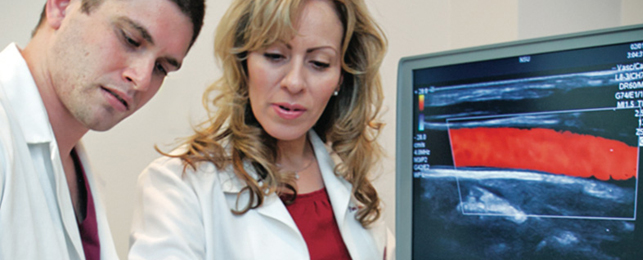
Medical Sonography Programs
About the Profession
Diagnostic Medical Sonography
Diagnostic medical sonography includes four primary areas of specialization: general (RDMS), cardiac (RDCS), vascular (RVT), and musculoskeletal (MSK). General sonography includes subspecialties in obstetrics and gynecology, organs of the body, and small parts (soft tissues and superficial glands), as well as neurosonology. Cardiac sonography examines the anatomical structure and function of the heart subdivided in three different subspecialties: Adult Echocardiography, Fetal Echocardiography, and Pediatric Echocardiography. Vascular sonography studies the anatomical and physiological characteristics of blood vessels (veins and arteries) in the human body. The most recently created specialty in sonography is Musculoskeletal sonography. This specialty studies the different joints and tendons in the body.
Diagnostic Medical Sonography uses mechanical, non-ionizing sound waves to obtain images and it is considered a non-invasive modality.
General Sonography
Professionals in this field are called Sonographers or Medical Sonographers. Sonographers use diagnostic medical ultrasound to obtain images of the internal organs such as the liver, gallbladder, bile ducts, pancreas, spleen, appendix, kidneys, and adrenal glands as well as images from superficial glands and soft tissues. Sonographers specializing in Obstetrics and Gynecology obtain images of the female pelvic organs and fetus, while those specializing in Neurosonology obtain images of the brain and its blood vessels. Sonographers working in all these specialties determine normal from abnormal situations and contribute to make diagnosis of pathologies affecting those organs.
Vascular Sonography
Professionals working in this specialty are called Vascular Sonographers. They use ultrasound and other specialized equipment to assess the anatomic, physiologic, and pathologic conditions of veins and arteries. Among the most common studies are those of the carotid arteries, arteries of the upper and lower extremities, abdominal blood vessels, and intracranial circulation. Exploration of these vessels helps to determine the presence of plaques, thrombus, direction of blood flow, process of revascularization, as well as patency of grafts. Vascular Sonographers play a very important role in assessing the blood vessels in special situations such as stroke, peripheral arterial disease, abdominal aortic aneurysm, portal hypertension, deep vein thrombosis, and even in helping to select native vessels for grafts to be used in cardiac surgeries.
General and Vascular Sonography Program
The NSU Bachelor of Science in Medical Sonography Program in Fort Lauderdale offers didactic and clinical training in General and Vascular sonography as an integrated curriculum. At the end of the program the student will be able to perform general (abdomen, small parts, and neurosonology), obstetrical and gynecological, as well as vascular studies. The growing use of ultrasound and the need for sonographers with multiple credentials to accommodate new regulations in the health care field have set the ground for a comprehensive program that combines these two main specialties with up to four (3) subspecialties: RDMS (Abdomen, OB-GYN, and Breast) and RVT.
Sonographers are important members of the diagnostic medical imaging or surgical team. They work closely with radiologists, cardiologists and vascular or general surgeons, as well as other allied professionals. Some sonographers own their own independent laboratories and provide services to physicians and hospitals. Others can seek careers in the industry among the manufacturers of ultrasound equipment in sales or applications, or plan a future in research or education.
Graduates of the Nova Southeastern program will be eligible to sit for the American Registry of Diagnostic Medical Sonography (ARDMS) registry examination. This exam is administered in 2 parts. The first part (SPI: Sonography Principles and Instrumentation) is geared toward evaluation of understanding of fundamental concepts in the technology of ultrasound. Students at Nova Southeastern University will be able to take this portion of the ARDMS exam upon successful completion of the Ultrasound Physics Course. The second part of the exam evaluates knowledge and understanding of anatomy, physiology, pathologies, quality assurance, examination protocols, etc. Students will be eligible to take this portion of the ARDMS upon graduation. This national registry is required in most institutions and hospitals for employment, and is the basis for licensing in the States of New Mexico and Oregon.